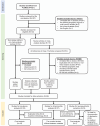The Prevalence and Clinical Phenotypes of Cluster Headache in Relation with Latitude
- PMID: 38441794
- PMCID: PMC11126473
- DOI: 10.1007/s11916-024-01229-3
The Prevalence and Clinical Phenotypes of Cluster Headache in Relation with Latitude
Abstract
Purpose of review: Previous studies have indicated a possible link between the prevalence of cluster headache (CH) and sunlight exposure. However, this theory has yet to be tested systemically. In this article, we aim to examine how latitude affects the prevalence and phenotypes of CH.
Recent findings: To our knowledge, there is by far no article describing the effect of latitude on disease phenotype; thus, we performed a literature review. We noted positive effects of latitude on 1-year prevalence, the proportion of chronic CH, and the proportion of miosis and/or ptosis. Latitude may affect the phenotypic presentations of cluster headache, probably partially mediated via temperature and sunlight variations. Still, other factors, such as environmental exposure to smoking and the genetic difference between the Eastern and Western populations, may participate in the pathogenesis and clinical manifestations of CH.
Keywords: 1-year prevalence; Cluster headache; Cranial autonomic symptoms; Latitude; Lifetime prevalence.
© 2024. The Author(s).
Conflict of interest statement
Both S.J. Wang and S.P. Chen own a position on editorial board at Current Pain and Headache Reports. YC Liaw declare no potential conflicts of interest. SJ Wang reports grants and personal fees from Novartis Taiwan, personal fees from Daiichi-Sankyo, grants and personal fees from Eli-Lilly, personal fees from AbbVie/Allergan, personal fees from Pfizer Taiwan, and personal fees from Biogen Taiwan, outside the submitted work.
Similar articles
-
Chronic Cluster Headache Update and East-West Comparisons: Focusing on Clinical Features, Pathophysiology, and Management.Curr Pain Headache Rep. 2020 Sep 29;24(11):68. doi: 10.1007/s11916-020-00902-7. Curr Pain Headache Rep. 2020. PMID: 32990832 Review.
-
Cluster Headache With Accompanying Migraine-Like Features: A Possible Clinical Phenotype.Headache. 2017 Feb;57(2):290-297. doi: 10.1111/head.12971. Epub 2016 Nov 10. Headache. 2017. PMID: 27861832
-
Differences of Cluster Headache on the Basis of Sex in the Korean Cluster Headache Registry.Headache. 2019 Nov;59(10):1722-1730. doi: 10.1111/head.13637. Epub 2019 Sep 18. Headache. 2019. PMID: 31535372
-
Cluster headache prevalence: methodological considerations. A review of the literature.Acta Biomed. 2006 Apr;77(1):4-9. Acta Biomed. 2006. PMID: 16856701 Review.
-
Clinical features of cluster headache without cranial autonomic symptoms: results from a prospective multicentre study.Sci Rep. 2021 Mar 25;11(1):6916. doi: 10.1038/s41598-021-86408-7. Sci Rep. 2021. PMID: 33767287 Free PMC article.
Cited by
-
Trigemino-autonomic activation in a human trigeminal pain model.BMC Neurol. 2025 Apr 5;25(1):145. doi: 10.1186/s12883-025-04147-y. BMC Neurol. 2025. PMID: 40188078 Free PMC article.
References
-
- Headache Classification Committee of the International Headache Society (IHS) The International Classification of Headache Disorders, 3rd edition. Cephalalgia. 2018;38(1):1–211. 10.1177/0333102417738202. PMID: 29368949. - PubMed
-
- Parnell GP, Schibeci SD, Fewings NL, Afrasiabi A, Law SPL, Samaranayake S, et al. The latitude-dependent autoimmune disease risk genes ZMIZ1 and IRF8 regulate mononuclear phagocytic cell differentiation in response to vitamin D. Hum Mol Genet. 2019;28(2):269–278. doi: 10.1093/hmg/ddy324. - DOI - PubMed
Publication types
MeSH terms
Grants and funding
- V113C-058, V112D67-001-MY3-2/Taipei Veterans General Hospital
- MOST110-2326-B-A49A-501-MY3, MOST112-2314-B-A49-037-MY3/Ministry of Science and Technology, Taiwan,Taiwan
- V113C-120, V113E-004-1/Taipei Veterans General Hospital,Taiwan
- MOST111-2314-B-075-086-MY3/Ministry of Science and Technology, Taiwan
LinkOut - more resources
Full Text Sources
Research Materials


